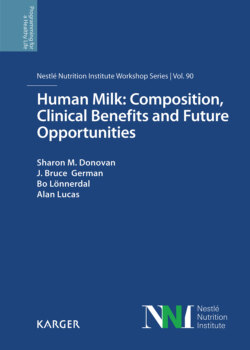Читать книгу Human Milk: Composition, Clinical Benefits and Future Opportunities - Группа авторов - Страница 42
На сайте Литреса книга снята с продажи.
Clinical Implications of the “Revised Suckling Physiology”
ОглавлениеBased on the evidence presented above, it is reassuring to learn that the standard tenets of good breastfeeding technique remain as true today as when they were first proposed [27, 28]. Enhancing the Positioning and Attachment of the baby at the breast will have the specific benefit of maximizing mouth:breast apposition. The greater the mouthful of breast tissue the baby takes, the further it will extend into the oral cavity, so providing a greater opportunity for the dorsum of the baby’s tongue to compress the underside of the teat. Explicitly, this will maximize the baby’s ability to amplify intraductal pressure during the suck, thereby boosting milk expression. Only when the duct ends have been opened by pressure from within, will added suction (ETDs) be capable of enhancing milk flow. No intervention has yet been identified which allows the level of suction that the baby produces to be modified (although the faster the rate of milk flow, the less suction pressure is likely to be applied). Accordingly, the basic tenets of Positioning and Attachment would apply here also.
